Learners and Learning: Constructive Feedback, Andragogy & LLN
VerifiedAdded on 2023/06/18
|19
|6144
|463
Homework Assignment
AI Summary
This assignment focuses on learners and learning, covering key areas such as constructive feedback, learner characteristics, andragogy, and Language, Literacy, and Numeracy (LLN) skills. It includes true/false questions, short answer explanations, and fill-in-the-gaps exercises to assess understanding of these concepts. The assignment explores the importance of providing specific, issue-focused feedback, understanding adult learning principles (andragogy), and recognizing the impact of LLN skills on learning outcomes. It also emphasizes the role of prior experience, self-belief, and personality in the learning process. The document aims to enhance the learner's ability to apply these concepts in practical training and assessment scenarios, with a focus on creating a productive and supportive learning environment. This resource is available on Desklib, a platform offering a wide array of study tools and solved assignments for students.
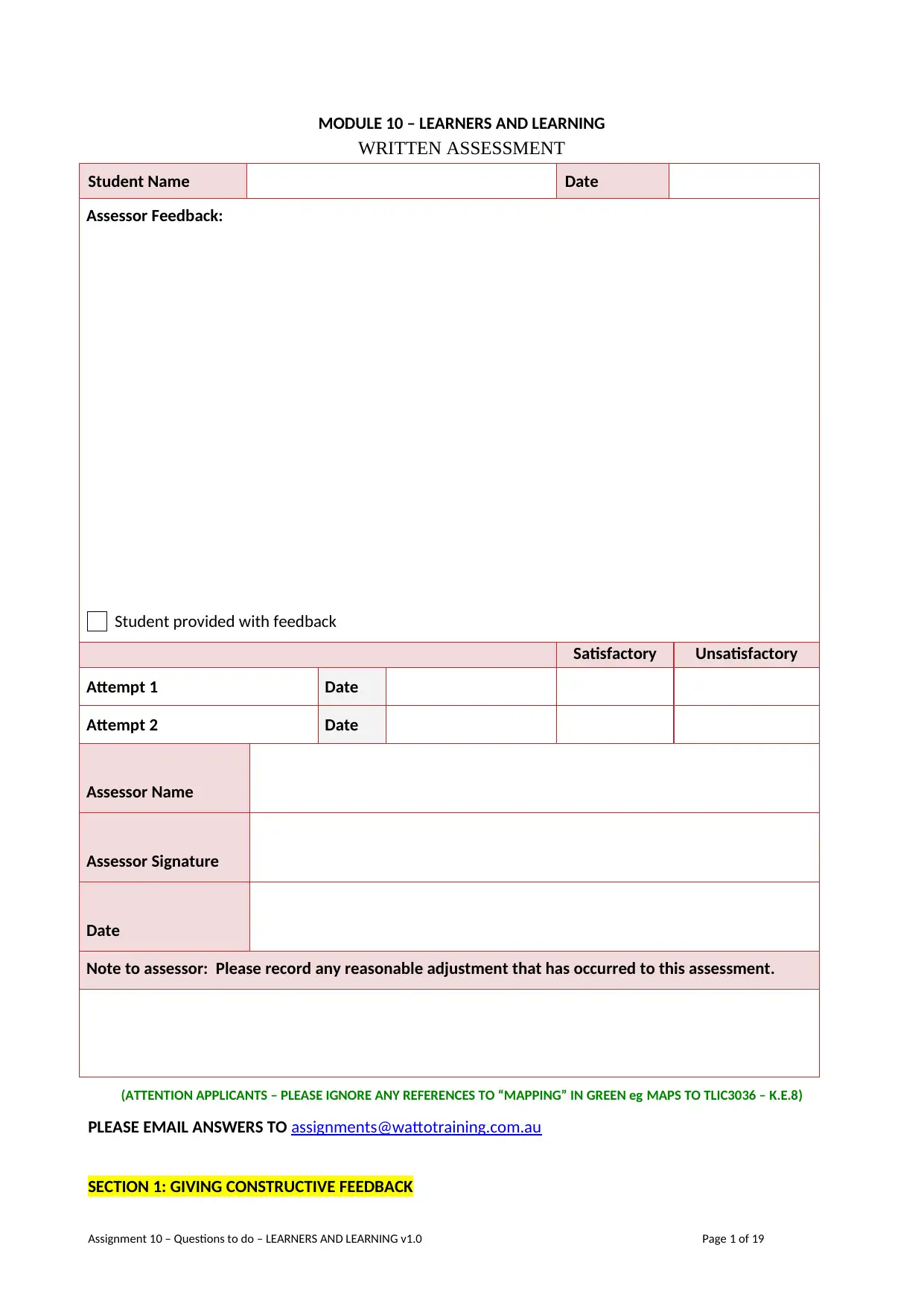
MODULE 10 – LEARNERS AND LEARNING
WRITTEN ASSESSMENT
Student Name Date
Assessor Feedback:
Student provided with feedback
Satisfactory Unsatisfactory
Attempt 1 Date
Attempt 2 Date
Assessor Name
Assessor Signature
Date
Note to assessor: Please record any reasonable adjustment that has occurred to this assessment.
(ATTENTION APPLICANTS – PLEASE IGNORE ANY REFERENCES TO “MAPPING” IN GREEN eg MAPS TO TLIC3036 – K.E.8)
PLEASE EMAIL ANSWERS TO assignments@wattotraining.com.au
SECTION 1: GIVING CONSTRUCTIVE FEEDBACK
Assignment 10 – Questions to do – LEARNERS AND LEARNING v1.0 Page 1 of 19
WRITTEN ASSESSMENT
Student Name Date
Assessor Feedback:
Student provided with feedback
Satisfactory Unsatisfactory
Attempt 1 Date
Attempt 2 Date
Assessor Name
Assessor Signature
Date
Note to assessor: Please record any reasonable adjustment that has occurred to this assessment.
(ATTENTION APPLICANTS – PLEASE IGNORE ANY REFERENCES TO “MAPPING” IN GREEN eg MAPS TO TLIC3036 – K.E.8)
PLEASE EMAIL ANSWERS TO assignments@wattotraining.com.au
SECTION 1: GIVING CONSTRUCTIVE FEEDBACK
Assignment 10 – Questions to do – LEARNERS AND LEARNING v1.0 Page 1 of 19
Paraphrase This Document
Need a fresh take? Get an instant paraphrase of this document with our AI Paraphraser
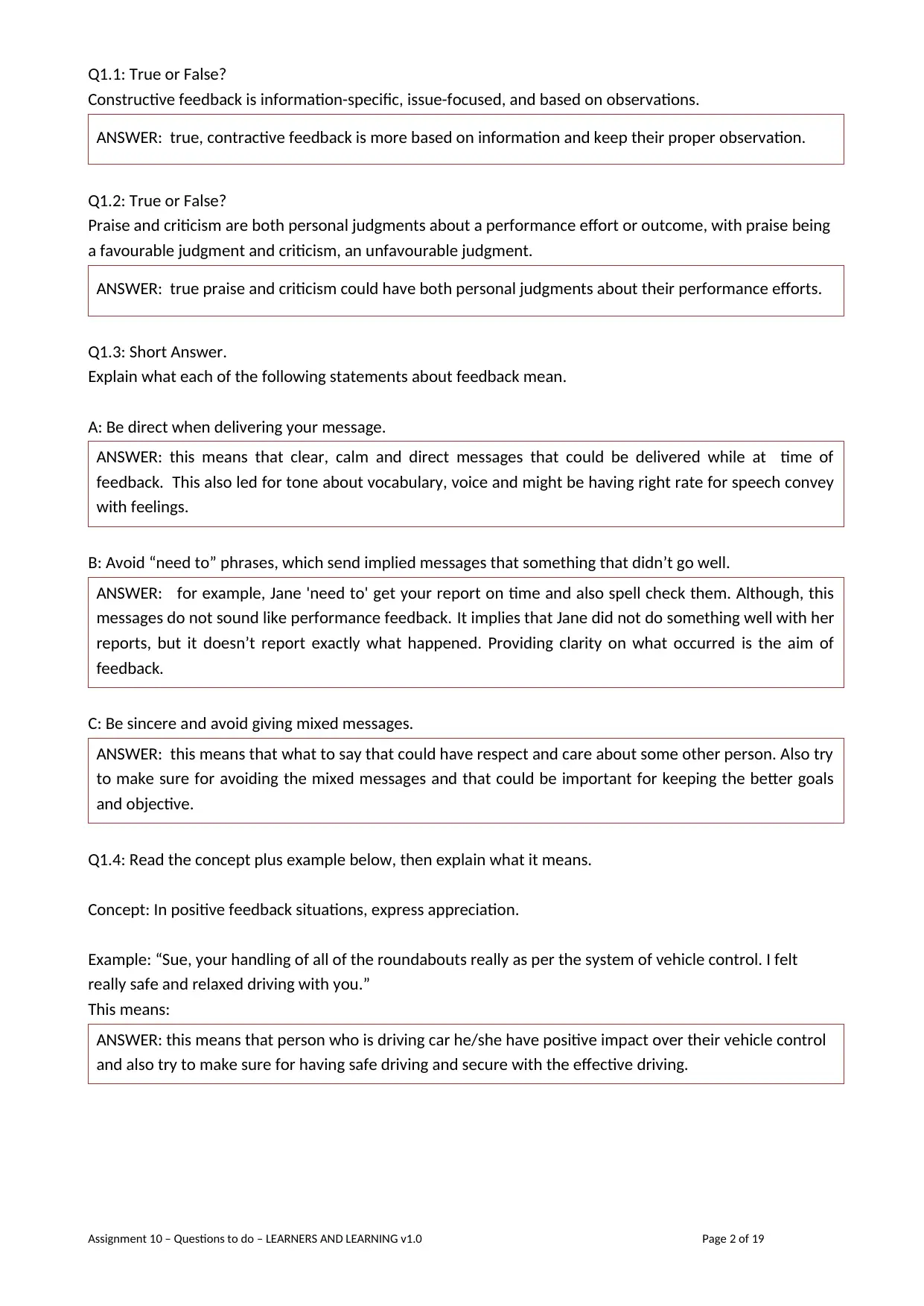
Q1.1: True or False?
Constructive feedback is information-specific, issue-focused, and based on observations.
ANSWER: true, contractive feedback is more based on information and keep their proper observation.
Q1.2: True or False?
Praise and criticism are both personal judgments about a performance effort or outcome, with praise being
a favourable judgment and criticism, an unfavourable judgment.
ANSWER: true praise and criticism could have both personal judgments about their performance efforts.
Q1.3: Short Answer.
Explain what each of the following statements about feedback mean.
A: Be direct when delivering your message.
ANSWER: this means that clear, calm and direct messages that could be delivered while at time of
feedback. This also led for tone about vocabulary, voice and might be having right rate for speech convey
with feelings.
B: Avoid “need to” phrases, which send implied messages that something that didn’t go well.
ANSWER: for example, Jane 'need to' get your report on time and also spell check them. Although, this
messages do not sound like performance feedback. It implies that Jane did not do something well with her
reports, but it doesn’t report exactly what happened. Providing clarity on what occurred is the aim of
feedback.
C: Be sincere and avoid giving mixed messages.
ANSWER: this means that what to say that could have respect and care about some other person. Also try
to make sure for avoiding the mixed messages and that could be important for keeping the better goals
and objective.
Q1.4: Read the concept plus example below, then explain what it means.
Concept: In positive feedback situations, express appreciation.
Example: “Sue, your handling of all of the roundabouts really as per the system of vehicle control. I felt
really safe and relaxed driving with you.”
This means:
ANSWER: this means that person who is driving car he/she have positive impact over their vehicle control
and also try to make sure for having safe driving and secure with the effective driving.
Assignment 10 – Questions to do – LEARNERS AND LEARNING v1.0 Page 2 of 19
Constructive feedback is information-specific, issue-focused, and based on observations.
ANSWER: true, contractive feedback is more based on information and keep their proper observation.
Q1.2: True or False?
Praise and criticism are both personal judgments about a performance effort or outcome, with praise being
a favourable judgment and criticism, an unfavourable judgment.
ANSWER: true praise and criticism could have both personal judgments about their performance efforts.
Q1.3: Short Answer.
Explain what each of the following statements about feedback mean.
A: Be direct when delivering your message.
ANSWER: this means that clear, calm and direct messages that could be delivered while at time of
feedback. This also led for tone about vocabulary, voice and might be having right rate for speech convey
with feelings.
B: Avoid “need to” phrases, which send implied messages that something that didn’t go well.
ANSWER: for example, Jane 'need to' get your report on time and also spell check them. Although, this
messages do not sound like performance feedback. It implies that Jane did not do something well with her
reports, but it doesn’t report exactly what happened. Providing clarity on what occurred is the aim of
feedback.
C: Be sincere and avoid giving mixed messages.
ANSWER: this means that what to say that could have respect and care about some other person. Also try
to make sure for avoiding the mixed messages and that could be important for keeping the better goals
and objective.
Q1.4: Read the concept plus example below, then explain what it means.
Concept: In positive feedback situations, express appreciation.
Example: “Sue, your handling of all of the roundabouts really as per the system of vehicle control. I felt
really safe and relaxed driving with you.”
This means:
ANSWER: this means that person who is driving car he/she have positive impact over their vehicle control
and also try to make sure for having safe driving and secure with the effective driving.
Assignment 10 – Questions to do – LEARNERS AND LEARNING v1.0 Page 2 of 19
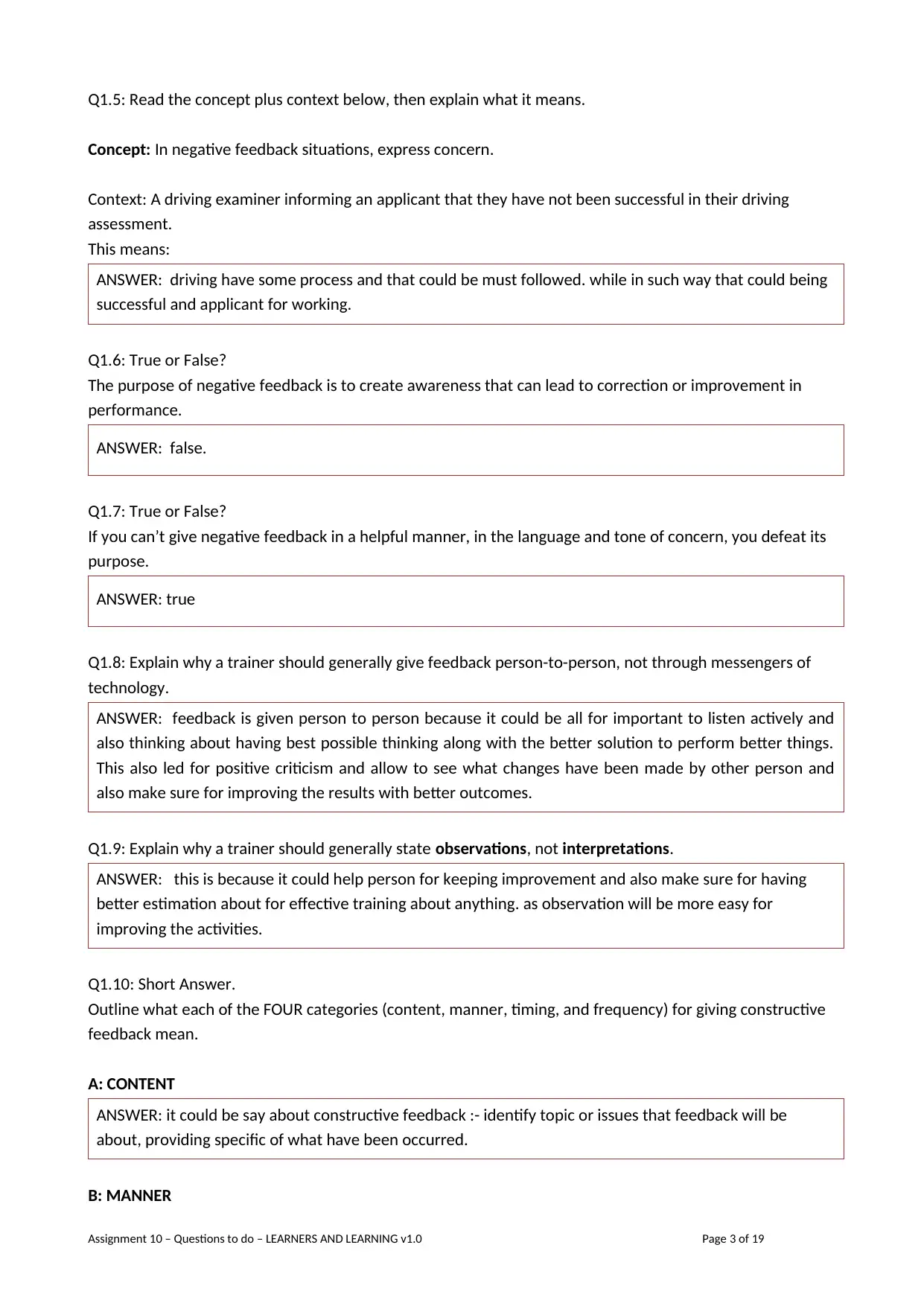
Q1.5: Read the concept plus context below, then explain what it means.
Concept: In negative feedback situations, express concern.
Context: A driving examiner informing an applicant that they have not been successful in their driving
assessment.
This means:
ANSWER: driving have some process and that could be must followed. while in such way that could being
successful and applicant for working.
Q1.6: True or False?
The purpose of negative feedback is to create awareness that can lead to correction or improvement in
performance.
ANSWER: false.
Q1.7: True or False?
If you can’t give negative feedback in a helpful manner, in the language and tone of concern, you defeat its
purpose.
ANSWER: true
Q1.8: Explain why a trainer should generally give feedback person-to-person, not through messengers of
technology.
ANSWER: feedback is given person to person because it could be all for important to listen actively and
also thinking about having best possible thinking along with the better solution to perform better things.
This also led for positive criticism and allow to see what changes have been made by other person and
also make sure for improving the results with better outcomes.
Q1.9: Explain why a trainer should generally state observations, not interpretations.
ANSWER: this is because it could help person for keeping improvement and also make sure for having
better estimation about for effective training about anything. as observation will be more easy for
improving the activities.
Q1.10: Short Answer.
Outline what each of the FOUR categories (content, manner, timing, and frequency) for giving constructive
feedback mean.
A: CONTENT
ANSWER: it could be say about constructive feedback :- identify topic or issues that feedback will be
about, providing specific of what have been occurred.
B: MANNER
Assignment 10 – Questions to do – LEARNERS AND LEARNING v1.0 Page 3 of 19
Concept: In negative feedback situations, express concern.
Context: A driving examiner informing an applicant that they have not been successful in their driving
assessment.
This means:
ANSWER: driving have some process and that could be must followed. while in such way that could being
successful and applicant for working.
Q1.6: True or False?
The purpose of negative feedback is to create awareness that can lead to correction or improvement in
performance.
ANSWER: false.
Q1.7: True or False?
If you can’t give negative feedback in a helpful manner, in the language and tone of concern, you defeat its
purpose.
ANSWER: true
Q1.8: Explain why a trainer should generally give feedback person-to-person, not through messengers of
technology.
ANSWER: feedback is given person to person because it could be all for important to listen actively and
also thinking about having best possible thinking along with the better solution to perform better things.
This also led for positive criticism and allow to see what changes have been made by other person and
also make sure for improving the results with better outcomes.
Q1.9: Explain why a trainer should generally state observations, not interpretations.
ANSWER: this is because it could help person for keeping improvement and also make sure for having
better estimation about for effective training about anything. as observation will be more easy for
improving the activities.
Q1.10: Short Answer.
Outline what each of the FOUR categories (content, manner, timing, and frequency) for giving constructive
feedback mean.
A: CONTENT
ANSWER: it could be say about constructive feedback :- identify topic or issues that feedback will be
about, providing specific of what have been occurred.
B: MANNER
Assignment 10 – Questions to do – LEARNERS AND LEARNING v1.0 Page 3 of 19
⊘ This is a preview!⊘
Do you want full access?
Subscribe today to unlock all pages.

Trusted by 1+ million students worldwide
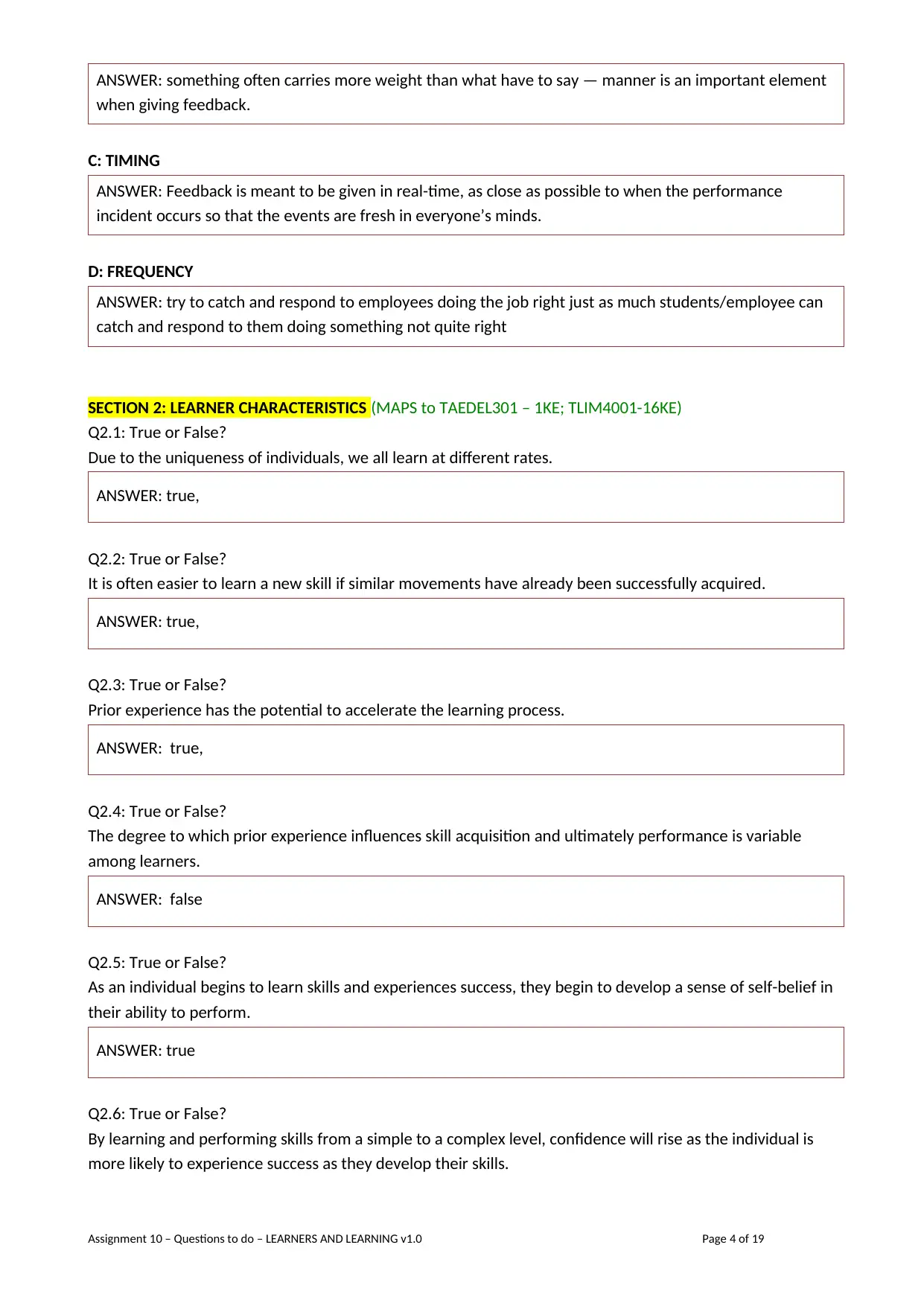
ANSWER: something often carries more weight than what have to say — manner is an important element
when giving feedback.
C: TIMING
ANSWER: Feedback is meant to be given in real-time, as close as possible to when the performance
incident occurs so that the events are fresh in everyone’s minds.
D: FREQUENCY
ANSWER: try to catch and respond to employees doing the job right just as much students/employee can
catch and respond to them doing something not quite right
SECTION 2: LEARNER CHARACTERISTICS (MAPS to TAEDEL301 – 1KE; TLIM4001-16KE)
Q2.1: True or False?
Due to the uniqueness of individuals, we all learn at different rates.
ANSWER: true,
Q2.2: True or False?
It is often easier to learn a new skill if similar movements have already been successfully acquired.
ANSWER: true,
Q2.3: True or False?
Prior experience has the potential to accelerate the learning process.
ANSWER: true,
Q2.4: True or False?
The degree to which prior experience influences skill acquisition and ultimately performance is variable
among learners.
ANSWER: false
Q2.5: True or False?
As an individual begins to learn skills and experiences success, they begin to develop a sense of self-belief in
their ability to perform.
ANSWER: true
Q2.6: True or False?
By learning and performing skills from a simple to a complex level, confidence will rise as the individual is
more likely to experience success as they develop their skills.
Assignment 10 – Questions to do – LEARNERS AND LEARNING v1.0 Page 4 of 19
when giving feedback.
C: TIMING
ANSWER: Feedback is meant to be given in real-time, as close as possible to when the performance
incident occurs so that the events are fresh in everyone’s minds.
D: FREQUENCY
ANSWER: try to catch and respond to employees doing the job right just as much students/employee can
catch and respond to them doing something not quite right
SECTION 2: LEARNER CHARACTERISTICS (MAPS to TAEDEL301 – 1KE; TLIM4001-16KE)
Q2.1: True or False?
Due to the uniqueness of individuals, we all learn at different rates.
ANSWER: true,
Q2.2: True or False?
It is often easier to learn a new skill if similar movements have already been successfully acquired.
ANSWER: true,
Q2.3: True or False?
Prior experience has the potential to accelerate the learning process.
ANSWER: true,
Q2.4: True or False?
The degree to which prior experience influences skill acquisition and ultimately performance is variable
among learners.
ANSWER: false
Q2.5: True or False?
As an individual begins to learn skills and experiences success, they begin to develop a sense of self-belief in
their ability to perform.
ANSWER: true
Q2.6: True or False?
By learning and performing skills from a simple to a complex level, confidence will rise as the individual is
more likely to experience success as they develop their skills.
Assignment 10 – Questions to do – LEARNERS AND LEARNING v1.0 Page 4 of 19
Paraphrase This Document
Need a fresh take? Get an instant paraphrase of this document with our AI Paraphraser
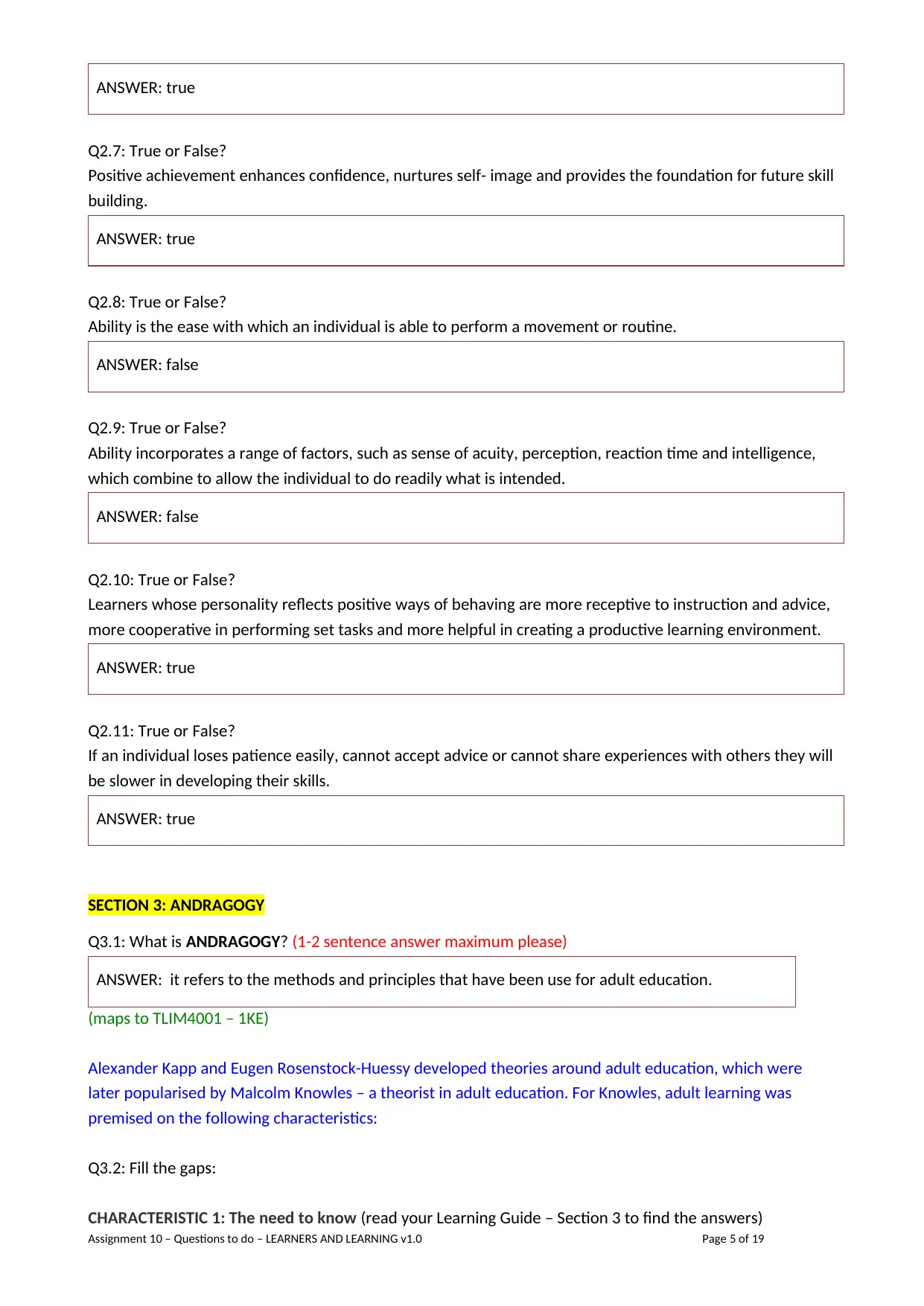
ANSWER: true
Q2.7: True or False?
Positive achievement enhances confidence, nurtures self- image and provides the foundation for future skill
building.
ANSWER: true
Q2.8: True or False?
Ability is the ease with which an individual is able to perform a movement or routine.
ANSWER: false
Q2.9: True or False?
Ability incorporates a range of factors, such as sense of acuity, perception, reaction time and intelligence,
which combine to allow the individual to do readily what is intended.
ANSWER: false
Q2.10: True or False?
Learners whose personality reflects positive ways of behaving are more receptive to instruction and advice,
more cooperative in performing set tasks and more helpful in creating a productive learning environment.
ANSWER: true
Q2.11: True or False?
If an individual loses patience easily, cannot accept advice or cannot share experiences with others they will
be slower in developing their skills.
ANSWER: true
SECTION 3: ANDRAGOGY
Q3.1: What is ANDRAGOGY? (1-2 sentence answer maximum please)
ANSWER: it refers to the methods and principles that have been use for adult education.
(maps to TLIM4001 – 1KE)
Alexander Kapp and Eugen Rosenstock-Huessy developed theories around adult education, which were
later popularised by Malcolm Knowles – a theorist in adult education. For Knowles, adult learning was
premised on the following characteristics:
Q3.2: Fill the gaps:
CHARACTERISTIC 1: The need to know (read your Learning Guide – Section 3 to find the answers)
Assignment 10 – Questions to do – LEARNERS AND LEARNING v1.0 Page 5 of 19
Q2.7: True or False?
Positive achievement enhances confidence, nurtures self- image and provides the foundation for future skill
building.
ANSWER: true
Q2.8: True or False?
Ability is the ease with which an individual is able to perform a movement or routine.
ANSWER: false
Q2.9: True or False?
Ability incorporates a range of factors, such as sense of acuity, perception, reaction time and intelligence,
which combine to allow the individual to do readily what is intended.
ANSWER: false
Q2.10: True or False?
Learners whose personality reflects positive ways of behaving are more receptive to instruction and advice,
more cooperative in performing set tasks and more helpful in creating a productive learning environment.
ANSWER: true
Q2.11: True or False?
If an individual loses patience easily, cannot accept advice or cannot share experiences with others they will
be slower in developing their skills.
ANSWER: true
SECTION 3: ANDRAGOGY
Q3.1: What is ANDRAGOGY? (1-2 sentence answer maximum please)
ANSWER: it refers to the methods and principles that have been use for adult education.
(maps to TLIM4001 – 1KE)
Alexander Kapp and Eugen Rosenstock-Huessy developed theories around adult education, which were
later popularised by Malcolm Knowles – a theorist in adult education. For Knowles, adult learning was
premised on the following characteristics:
Q3.2: Fill the gaps:
CHARACTERISTIC 1: The need to know (read your Learning Guide – Section 3 to find the answers)
Assignment 10 – Questions to do – LEARNERS AND LEARNING v1.0 Page 5 of 19
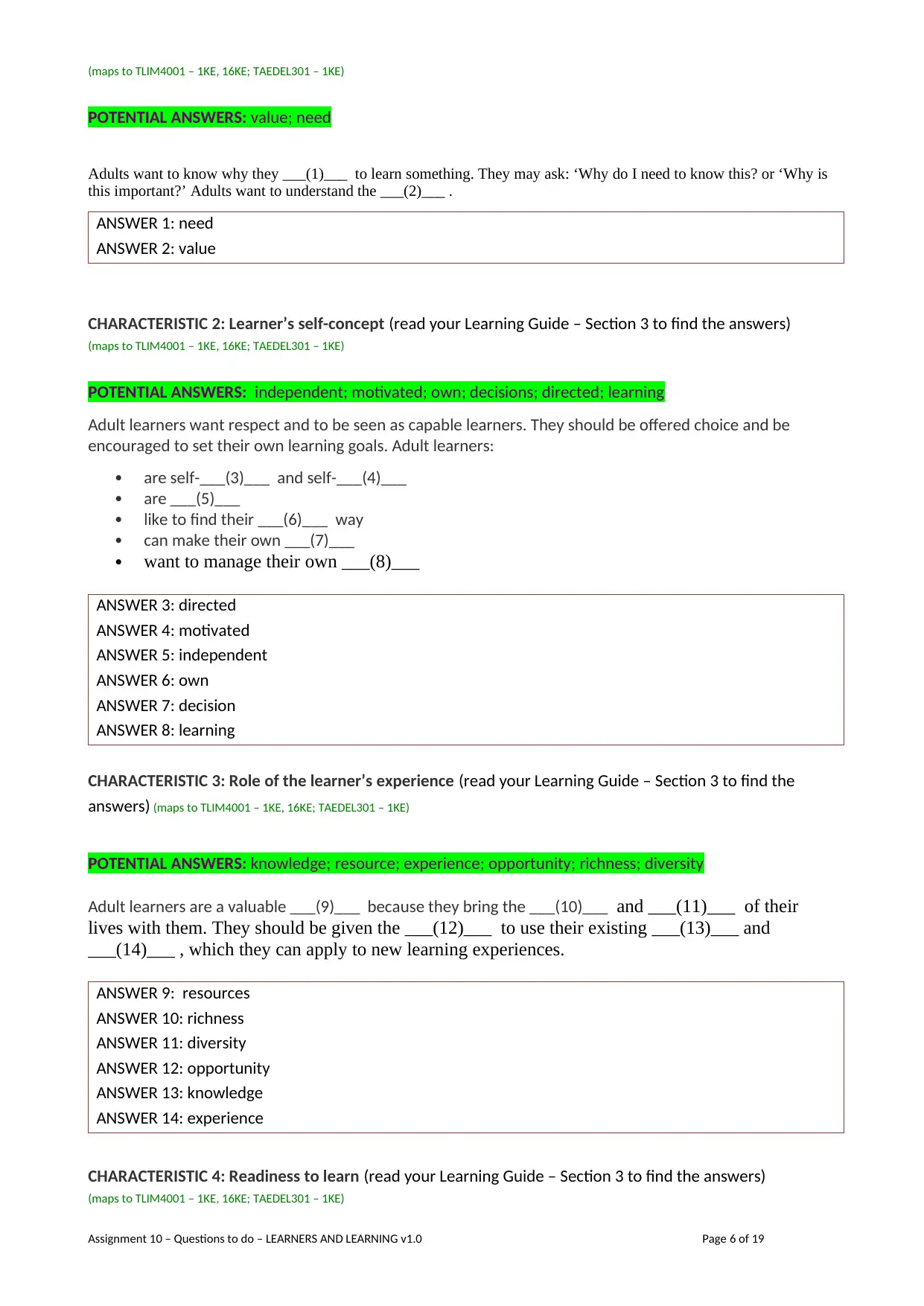
(maps to TLIM4001 – 1KE, 16KE; TAEDEL301 – 1KE)
POTENTIAL ANSWERS: value; need
Adults want to know why they ___(1)___ to learn something. They may ask: ‘Why do I need to know this? or ‘Why is
this important?’ Adults want to understand the ___(2)___ .
ANSWER 1: need
ANSWER 2: value
CHARACTERISTIC 2: Learner’s self-concept (read your Learning Guide – Section 3 to find the answers)
(maps to TLIM4001 – 1KE, 16KE; TAEDEL301 – 1KE)
POTENTIAL ANSWERS: independent; motivated; own; decisions; directed; learning
Adult learners want respect and to be seen as capable learners. They should be offered choice and be
encouraged to set their own learning goals. Adult learners:
are self-___(3)___ and self-___(4)___
are ___(5)___
like to find their ___(6)___ way
can make their own ___(7)___
want to manage their own ___(8)___
ANSWER 3: directed
ANSWER 4: motivated
ANSWER 5: independent
ANSWER 6: own
ANSWER 7: decision
ANSWER 8: learning
CHARACTERISTIC 3: Role of the learner’s experience (read your Learning Guide – Section 3 to find the
answers) (maps to TLIM4001 – 1KE, 16KE; TAEDEL301 – 1KE)
POTENTIAL ANSWERS: knowledge; resource; experience; opportunity; richness; diversity
Adult learners are a valuable ___(9)___ because they bring the ___(10)___ and ___(11)___ of their
lives with them. They should be given the ___(12)___ to use their existing ___(13)___ and
___(14)___ , which they can apply to new learning experiences.
ANSWER 9: resources
ANSWER 10: richness
ANSWER 11: diversity
ANSWER 12: opportunity
ANSWER 13: knowledge
ANSWER 14: experience
CHARACTERISTIC 4: Readiness to learn (read your Learning Guide – Section 3 to find the answers)
(maps to TLIM4001 – 1KE, 16KE; TAEDEL301 – 1KE)
Assignment 10 – Questions to do – LEARNERS AND LEARNING v1.0 Page 6 of 19
POTENTIAL ANSWERS: value; need
Adults want to know why they ___(1)___ to learn something. They may ask: ‘Why do I need to know this? or ‘Why is
this important?’ Adults want to understand the ___(2)___ .
ANSWER 1: need
ANSWER 2: value
CHARACTERISTIC 2: Learner’s self-concept (read your Learning Guide – Section 3 to find the answers)
(maps to TLIM4001 – 1KE, 16KE; TAEDEL301 – 1KE)
POTENTIAL ANSWERS: independent; motivated; own; decisions; directed; learning
Adult learners want respect and to be seen as capable learners. They should be offered choice and be
encouraged to set their own learning goals. Adult learners:
are self-___(3)___ and self-___(4)___
are ___(5)___
like to find their ___(6)___ way
can make their own ___(7)___
want to manage their own ___(8)___
ANSWER 3: directed
ANSWER 4: motivated
ANSWER 5: independent
ANSWER 6: own
ANSWER 7: decision
ANSWER 8: learning
CHARACTERISTIC 3: Role of the learner’s experience (read your Learning Guide – Section 3 to find the
answers) (maps to TLIM4001 – 1KE, 16KE; TAEDEL301 – 1KE)
POTENTIAL ANSWERS: knowledge; resource; experience; opportunity; richness; diversity
Adult learners are a valuable ___(9)___ because they bring the ___(10)___ and ___(11)___ of their
lives with them. They should be given the ___(12)___ to use their existing ___(13)___ and
___(14)___ , which they can apply to new learning experiences.
ANSWER 9: resources
ANSWER 10: richness
ANSWER 11: diversity
ANSWER 12: opportunity
ANSWER 13: knowledge
ANSWER 14: experience
CHARACTERISTIC 4: Readiness to learn (read your Learning Guide – Section 3 to find the answers)
(maps to TLIM4001 – 1KE, 16KE; TAEDEL301 – 1KE)
Assignment 10 – Questions to do – LEARNERS AND LEARNING v1.0 Page 6 of 19
⊘ This is a preview!⊘
Do you want full access?
Subscribe today to unlock all pages.

Trusted by 1+ million students worldwide
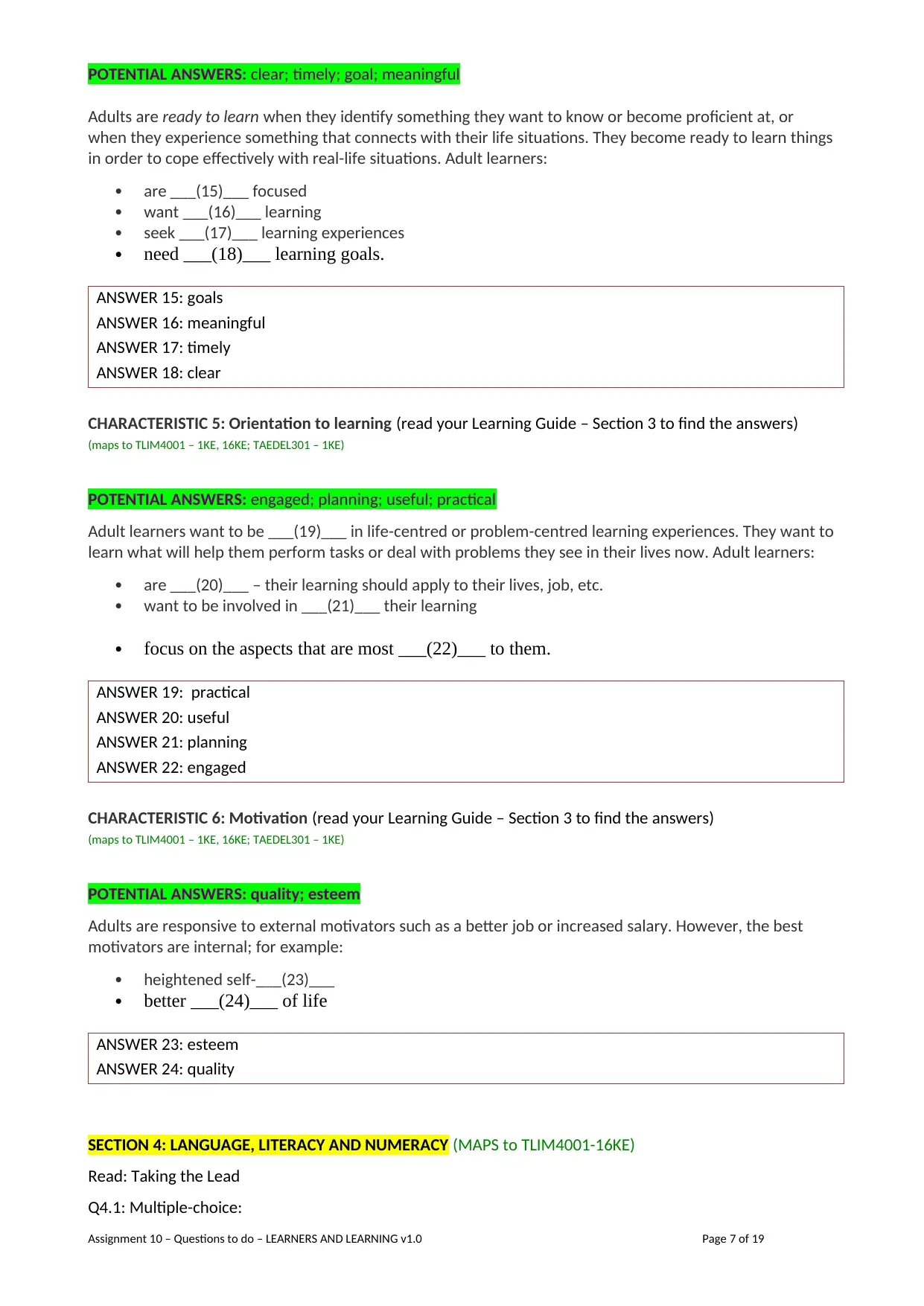
POTENTIAL ANSWERS: clear; timely; goal; meaningful
Adults are ready to learn when they identify something they want to know or become proficient at, or
when they experience something that connects with their life situations. They become ready to learn things
in order to cope effectively with real-life situations. Adult learners:
are ___(15)___ focused
want ___(16)___ learning
seek ___(17)___ learning experiences
need ___(18)___ learning goals.
ANSWER 15: goals
ANSWER 16: meaningful
ANSWER 17: timely
ANSWER 18: clear
CHARACTERISTIC 5: Orientation to learning (read your Learning Guide – Section 3 to find the answers)
(maps to TLIM4001 – 1KE, 16KE; TAEDEL301 – 1KE)
POTENTIAL ANSWERS: engaged; planning; useful; practical
Adult learners want to be ___(19)___ in life-centred or problem-centred learning experiences. They want to
learn what will help them perform tasks or deal with problems they see in their lives now. Adult learners:
are ___(20)___ – their learning should apply to their lives, job, etc.
want to be involved in ___(21)___ their learning
focus on the aspects that are most ___(22)___ to them.
ANSWER 19: practical
ANSWER 20: useful
ANSWER 21: planning
ANSWER 22: engaged
CHARACTERISTIC 6: Motivation (read your Learning Guide – Section 3 to find the answers)
(maps to TLIM4001 – 1KE, 16KE; TAEDEL301 – 1KE)
POTENTIAL ANSWERS: quality; esteem
Adults are responsive to external motivators such as a better job or increased salary. However, the best
motivators are internal; for example:
heightened self-___(23)___
better ___(24)___ of life
ANSWER 23: esteem
ANSWER 24: quality
SECTION 4: LANGUAGE, LITERACY AND NUMERACY (MAPS to TLIM4001-16KE)
Read: Taking the Lead
Q4.1: Multiple-choice:
Assignment 10 – Questions to do – LEARNERS AND LEARNING v1.0 Page 7 of 19
Adults are ready to learn when they identify something they want to know or become proficient at, or
when they experience something that connects with their life situations. They become ready to learn things
in order to cope effectively with real-life situations. Adult learners:
are ___(15)___ focused
want ___(16)___ learning
seek ___(17)___ learning experiences
need ___(18)___ learning goals.
ANSWER 15: goals
ANSWER 16: meaningful
ANSWER 17: timely
ANSWER 18: clear
CHARACTERISTIC 5: Orientation to learning (read your Learning Guide – Section 3 to find the answers)
(maps to TLIM4001 – 1KE, 16KE; TAEDEL301 – 1KE)
POTENTIAL ANSWERS: engaged; planning; useful; practical
Adult learners want to be ___(19)___ in life-centred or problem-centred learning experiences. They want to
learn what will help them perform tasks or deal with problems they see in their lives now. Adult learners:
are ___(20)___ – their learning should apply to their lives, job, etc.
want to be involved in ___(21)___ their learning
focus on the aspects that are most ___(22)___ to them.
ANSWER 19: practical
ANSWER 20: useful
ANSWER 21: planning
ANSWER 22: engaged
CHARACTERISTIC 6: Motivation (read your Learning Guide – Section 3 to find the answers)
(maps to TLIM4001 – 1KE, 16KE; TAEDEL301 – 1KE)
POTENTIAL ANSWERS: quality; esteem
Adults are responsive to external motivators such as a better job or increased salary. However, the best
motivators are internal; for example:
heightened self-___(23)___
better ___(24)___ of life
ANSWER 23: esteem
ANSWER 24: quality
SECTION 4: LANGUAGE, LITERACY AND NUMERACY (MAPS to TLIM4001-16KE)
Read: Taking the Lead
Q4.1: Multiple-choice:
Assignment 10 – Questions to do – LEARNERS AND LEARNING v1.0 Page 7 of 19
Paraphrase This Document
Need a fresh take? Get an instant paraphrase of this document with our AI Paraphraser
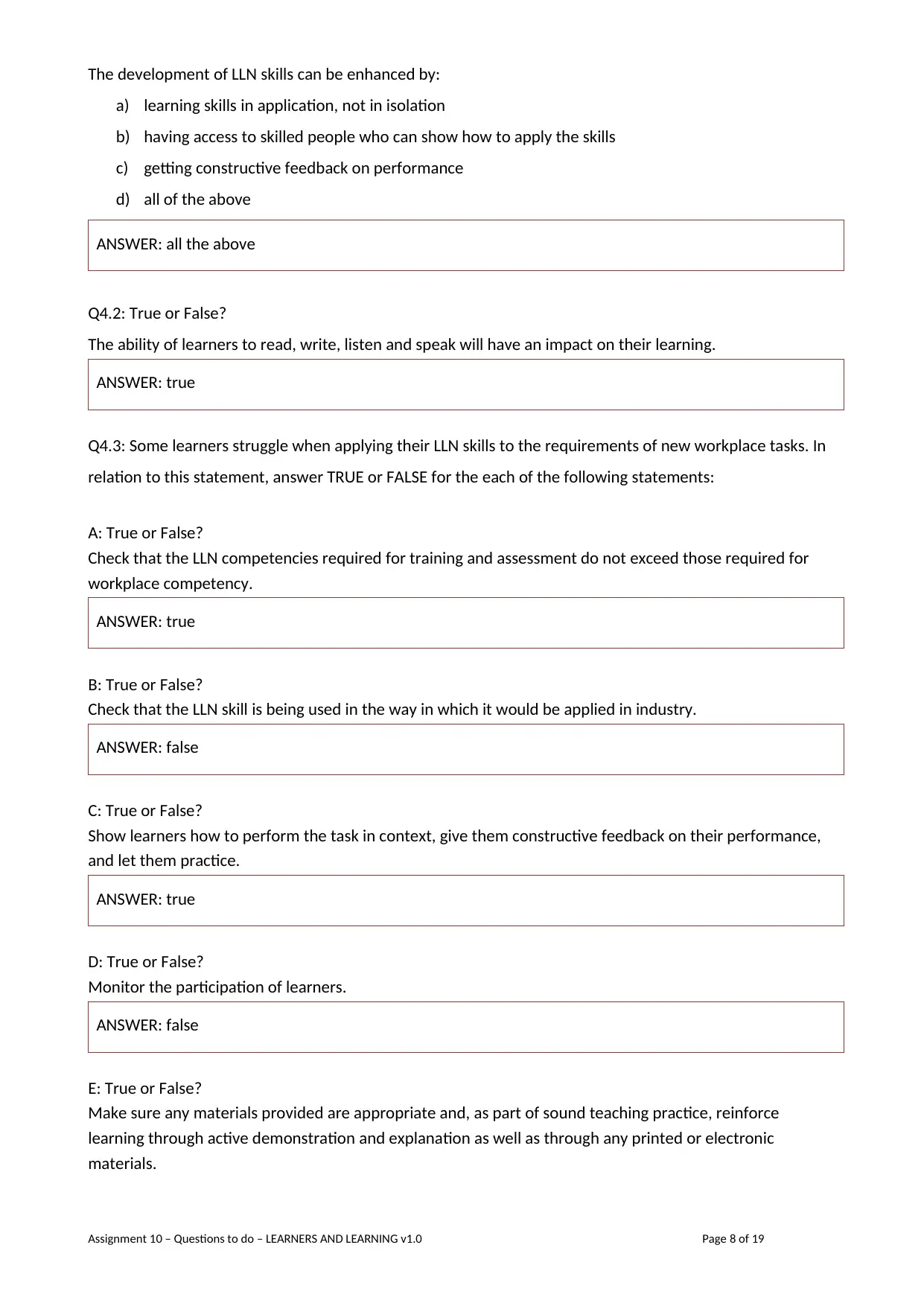
The development of LLN skills can be enhanced by:
a) learning skills in application, not in isolation
b) having access to skilled people who can show how to apply the skills
c) getting constructive feedback on performance
d) all of the above
ANSWER: all the above
Q4.2: True or False?
The ability of learners to read, write, listen and speak will have an impact on their learning.
ANSWER: true
Q4.3: Some learners struggle when applying their LLN skills to the requirements of new workplace tasks. In
relation to this statement, answer TRUE or FALSE for the each of the following statements:
A: True or False?
Check that the LLN competencies required for training and assessment do not exceed those required for
workplace competency.
ANSWER: true
B: True or False?
Check that the LLN skill is being used in the way in which it would be applied in industry.
ANSWER: false
C: True or False?
Show learners how to perform the task in context, give them constructive feedback on their performance,
and let them practice.
ANSWER: true
D: True or False?
Monitor the participation of learners.
ANSWER: false
E: True or False?
Make sure any materials provided are appropriate and, as part of sound teaching practice, reinforce
learning through active demonstration and explanation as well as through any printed or electronic
materials.
Assignment 10 – Questions to do – LEARNERS AND LEARNING v1.0 Page 8 of 19
a) learning skills in application, not in isolation
b) having access to skilled people who can show how to apply the skills
c) getting constructive feedback on performance
d) all of the above
ANSWER: all the above
Q4.2: True or False?
The ability of learners to read, write, listen and speak will have an impact on their learning.
ANSWER: true
Q4.3: Some learners struggle when applying their LLN skills to the requirements of new workplace tasks. In
relation to this statement, answer TRUE or FALSE for the each of the following statements:
A: True or False?
Check that the LLN competencies required for training and assessment do not exceed those required for
workplace competency.
ANSWER: true
B: True or False?
Check that the LLN skill is being used in the way in which it would be applied in industry.
ANSWER: false
C: True or False?
Show learners how to perform the task in context, give them constructive feedback on their performance,
and let them practice.
ANSWER: true
D: True or False?
Monitor the participation of learners.
ANSWER: false
E: True or False?
Make sure any materials provided are appropriate and, as part of sound teaching practice, reinforce
learning through active demonstration and explanation as well as through any printed or electronic
materials.
Assignment 10 – Questions to do – LEARNERS AND LEARNING v1.0 Page 8 of 19
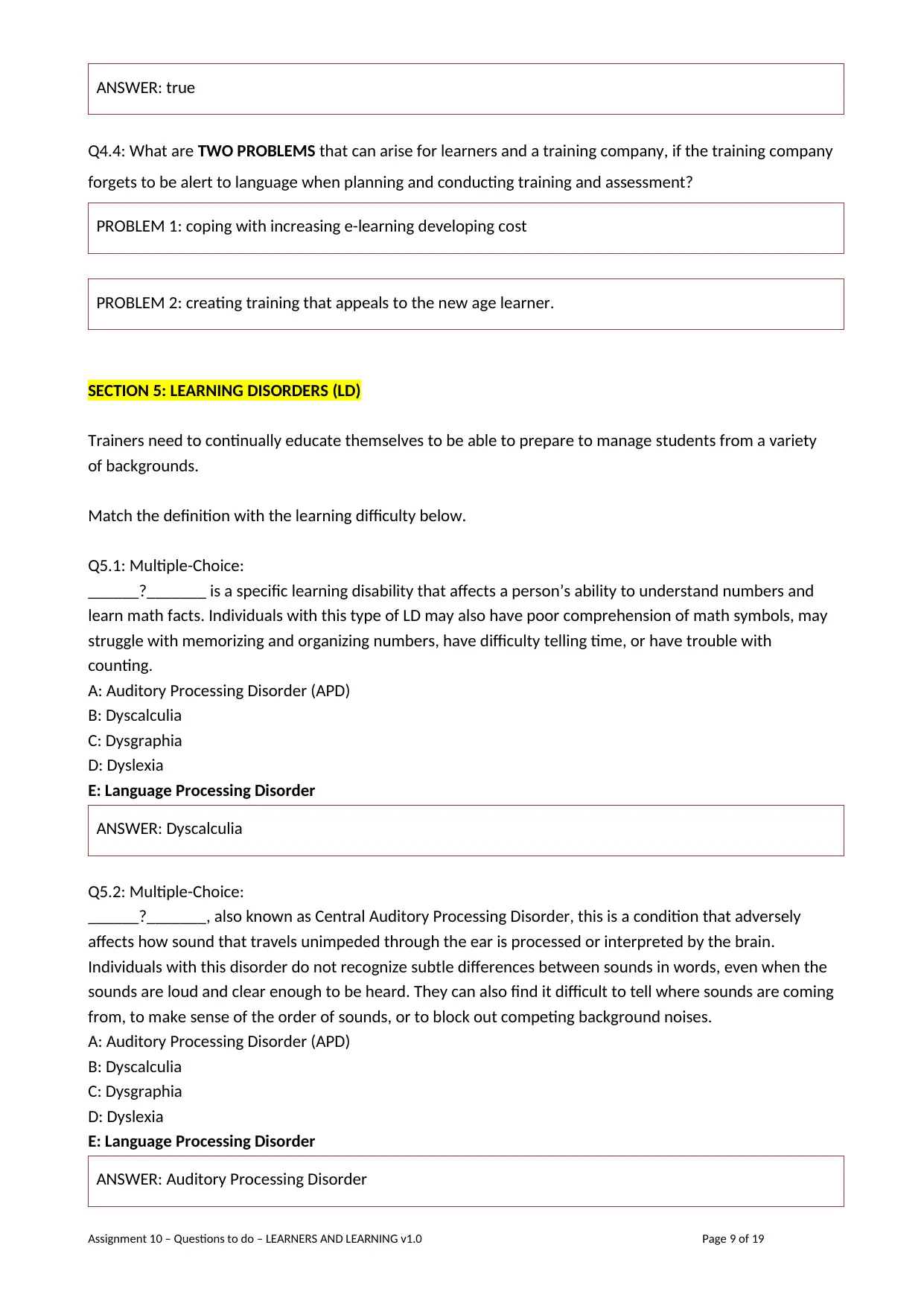
ANSWER: true
Q4.4: What are TWO PROBLEMS that can arise for learners and a training company, if the training company
forgets to be alert to language when planning and conducting training and assessment?
PROBLEM 1: coping with increasing e-learning developing cost
PROBLEM 2: creating training that appeals to the new age learner.
SECTION 5: LEARNING DISORDERS (LD)
Trainers need to continually educate themselves to be able to prepare to manage students from a variety
of backgrounds.
Match the definition with the learning difficulty below.
Q5.1: Multiple-Choice:
______?_______ is a specific learning disability that affects a person’s ability to understand numbers and
learn math facts. Individuals with this type of LD may also have poor comprehension of math symbols, may
struggle with memorizing and organizing numbers, have difficulty telling time, or have trouble with
counting.
A: Auditory Processing Disorder (APD)
B: Dyscalculia
C: Dysgraphia
D: Dyslexia
E: Language Processing Disorder
ANSWER: Dyscalculia
Q5.2: Multiple-Choice:
______?_______, also known as Central Auditory Processing Disorder, this is a condition that adversely
affects how sound that travels unimpeded through the ear is processed or interpreted by the brain.
Individuals with this disorder do not recognize subtle differences between sounds in words, even when the
sounds are loud and clear enough to be heard. They can also find it difficult to tell where sounds are coming
from, to make sense of the order of sounds, or to block out competing background noises.
A: Auditory Processing Disorder (APD)
B: Dyscalculia
C: Dysgraphia
D: Dyslexia
E: Language Processing Disorder
ANSWER: Auditory Processing Disorder
Assignment 10 – Questions to do – LEARNERS AND LEARNING v1.0 Page 9 of 19
Q4.4: What are TWO PROBLEMS that can arise for learners and a training company, if the training company
forgets to be alert to language when planning and conducting training and assessment?
PROBLEM 1: coping with increasing e-learning developing cost
PROBLEM 2: creating training that appeals to the new age learner.
SECTION 5: LEARNING DISORDERS (LD)
Trainers need to continually educate themselves to be able to prepare to manage students from a variety
of backgrounds.
Match the definition with the learning difficulty below.
Q5.1: Multiple-Choice:
______?_______ is a specific learning disability that affects a person’s ability to understand numbers and
learn math facts. Individuals with this type of LD may also have poor comprehension of math symbols, may
struggle with memorizing and organizing numbers, have difficulty telling time, or have trouble with
counting.
A: Auditory Processing Disorder (APD)
B: Dyscalculia
C: Dysgraphia
D: Dyslexia
E: Language Processing Disorder
ANSWER: Dyscalculia
Q5.2: Multiple-Choice:
______?_______, also known as Central Auditory Processing Disorder, this is a condition that adversely
affects how sound that travels unimpeded through the ear is processed or interpreted by the brain.
Individuals with this disorder do not recognize subtle differences between sounds in words, even when the
sounds are loud and clear enough to be heard. They can also find it difficult to tell where sounds are coming
from, to make sense of the order of sounds, or to block out competing background noises.
A: Auditory Processing Disorder (APD)
B: Dyscalculia
C: Dysgraphia
D: Dyslexia
E: Language Processing Disorder
ANSWER: Auditory Processing Disorder
Assignment 10 – Questions to do – LEARNERS AND LEARNING v1.0 Page 9 of 19
⊘ This is a preview!⊘
Do you want full access?
Subscribe today to unlock all pages.

Trusted by 1+ million students worldwide
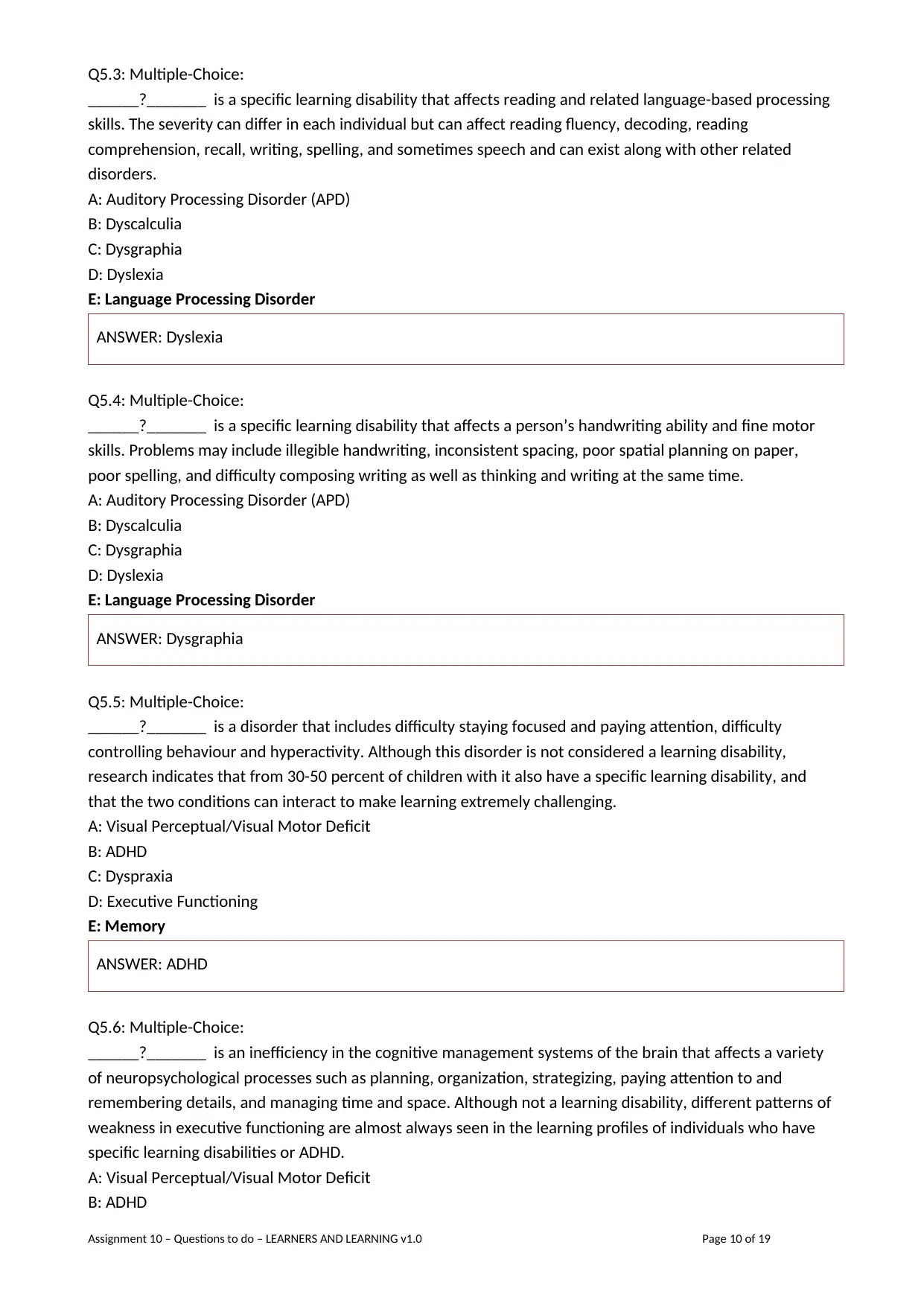
Q5.3: Multiple-Choice:
______?_______ is a specific learning disability that affects reading and related language-based processing
skills. The severity can differ in each individual but can affect reading fluency, decoding, reading
comprehension, recall, writing, spelling, and sometimes speech and can exist along with other related
disorders.
A: Auditory Processing Disorder (APD)
B: Dyscalculia
C: Dysgraphia
D: Dyslexia
E: Language Processing Disorder
ANSWER: Dyslexia
Q5.4: Multiple-Choice:
______?_______ is a specific learning disability that affects a person’s handwriting ability and fine motor
skills. Problems may include illegible handwriting, inconsistent spacing, poor spatial planning on paper,
poor spelling, and difficulty composing writing as well as thinking and writing at the same time.
A: Auditory Processing Disorder (APD)
B: Dyscalculia
C: Dysgraphia
D: Dyslexia
E: Language Processing Disorder
ANSWER: Dysgraphia
Q5.5: Multiple-Choice:
______?_______ is a disorder that includes difficulty staying focused and paying attention, difficulty
controlling behaviour and hyperactivity. Although this disorder is not considered a learning disability,
research indicates that from 30-50 percent of children with it also have a specific learning disability, and
that the two conditions can interact to make learning extremely challenging.
A: Visual Perceptual/Visual Motor Deficit
B: ADHD
C: Dyspraxia
D: Executive Functioning
E: Memory
ANSWER: ADHD
Q5.6: Multiple-Choice:
______?_______ is an inefficiency in the cognitive management systems of the brain that affects a variety
of neuropsychological processes such as planning, organization, strategizing, paying attention to and
remembering details, and managing time and space. Although not a learning disability, different patterns of
weakness in executive functioning are almost always seen in the learning profiles of individuals who have
specific learning disabilities or ADHD.
A: Visual Perceptual/Visual Motor Deficit
B: ADHD
Assignment 10 – Questions to do – LEARNERS AND LEARNING v1.0 Page 10 of 19
______?_______ is a specific learning disability that affects reading and related language-based processing
skills. The severity can differ in each individual but can affect reading fluency, decoding, reading
comprehension, recall, writing, spelling, and sometimes speech and can exist along with other related
disorders.
A: Auditory Processing Disorder (APD)
B: Dyscalculia
C: Dysgraphia
D: Dyslexia
E: Language Processing Disorder
ANSWER: Dyslexia
Q5.4: Multiple-Choice:
______?_______ is a specific learning disability that affects a person’s handwriting ability and fine motor
skills. Problems may include illegible handwriting, inconsistent spacing, poor spatial planning on paper,
poor spelling, and difficulty composing writing as well as thinking and writing at the same time.
A: Auditory Processing Disorder (APD)
B: Dyscalculia
C: Dysgraphia
D: Dyslexia
E: Language Processing Disorder
ANSWER: Dysgraphia
Q5.5: Multiple-Choice:
______?_______ is a disorder that includes difficulty staying focused and paying attention, difficulty
controlling behaviour and hyperactivity. Although this disorder is not considered a learning disability,
research indicates that from 30-50 percent of children with it also have a specific learning disability, and
that the two conditions can interact to make learning extremely challenging.
A: Visual Perceptual/Visual Motor Deficit
B: ADHD
C: Dyspraxia
D: Executive Functioning
E: Memory
ANSWER: ADHD
Q5.6: Multiple-Choice:
______?_______ is an inefficiency in the cognitive management systems of the brain that affects a variety
of neuropsychological processes such as planning, organization, strategizing, paying attention to and
remembering details, and managing time and space. Although not a learning disability, different patterns of
weakness in executive functioning are almost always seen in the learning profiles of individuals who have
specific learning disabilities or ADHD.
A: Visual Perceptual/Visual Motor Deficit
B: ADHD
Assignment 10 – Questions to do – LEARNERS AND LEARNING v1.0 Page 10 of 19
Paraphrase This Document
Need a fresh take? Get an instant paraphrase of this document with our AI Paraphraser
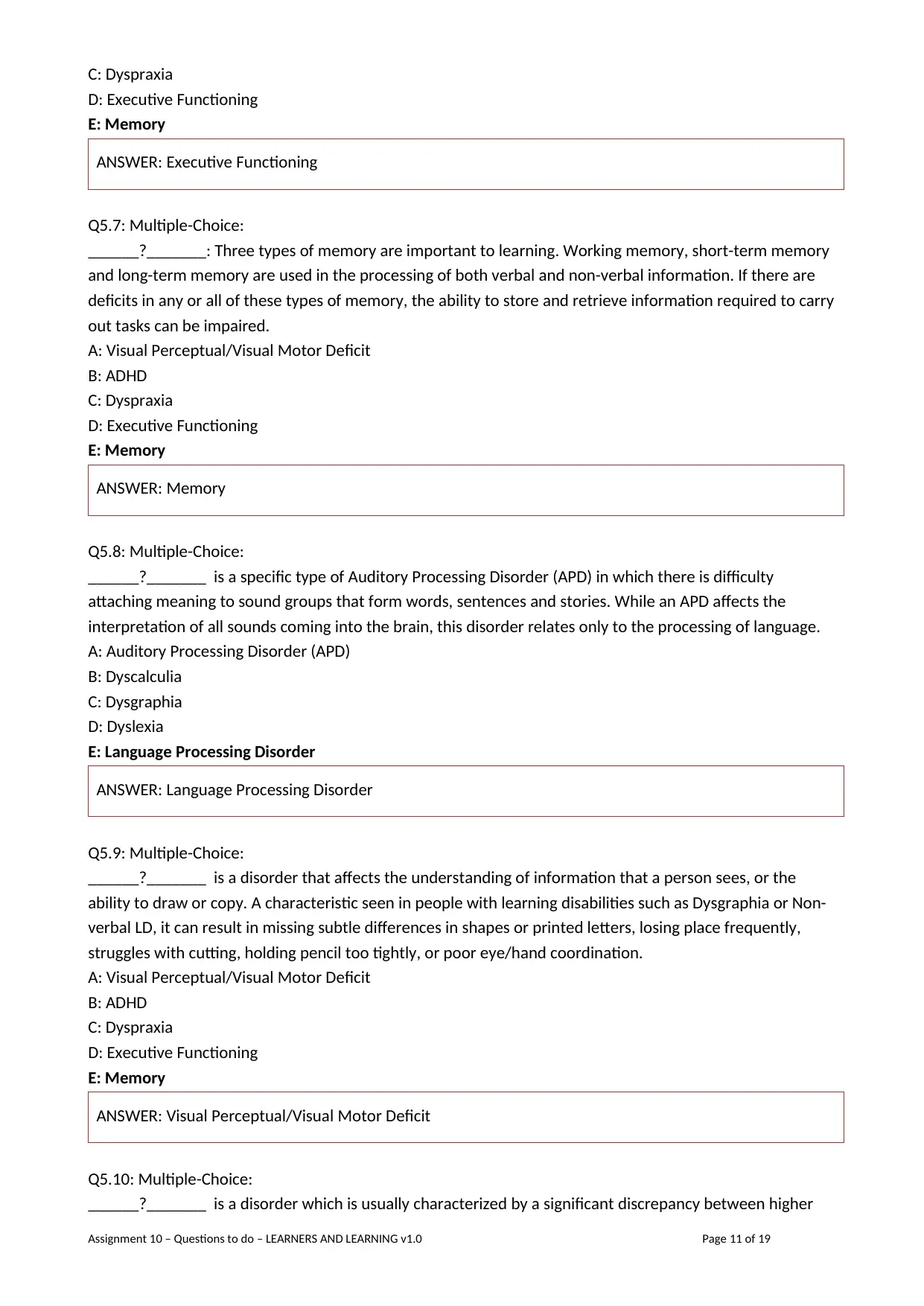
C: Dyspraxia
D: Executive Functioning
E: Memory
ANSWER: Executive Functioning
Q5.7: Multiple-Choice:
______?_______: Three types of memory are important to learning. Working memory, short-term memory
and long-term memory are used in the processing of both verbal and non-verbal information. If there are
deficits in any or all of these types of memory, the ability to store and retrieve information required to carry
out tasks can be impaired.
A: Visual Perceptual/Visual Motor Deficit
B: ADHD
C: Dyspraxia
D: Executive Functioning
E: Memory
ANSWER: Memory
Q5.8: Multiple-Choice:
______?_______ is a specific type of Auditory Processing Disorder (APD) in which there is difficulty
attaching meaning to sound groups that form words, sentences and stories. While an APD affects the
interpretation of all sounds coming into the brain, this disorder relates only to the processing of language.
A: Auditory Processing Disorder (APD)
B: Dyscalculia
C: Dysgraphia
D: Dyslexia
E: Language Processing Disorder
ANSWER: Language Processing Disorder
Q5.9: Multiple-Choice:
______?_______ is a disorder that affects the understanding of information that a person sees, or the
ability to draw or copy. A characteristic seen in people with learning disabilities such as Dysgraphia or Non-
verbal LD, it can result in missing subtle differences in shapes or printed letters, losing place frequently,
struggles with cutting, holding pencil too tightly, or poor eye/hand coordination.
A: Visual Perceptual/Visual Motor Deficit
B: ADHD
C: Dyspraxia
D: Executive Functioning
E: Memory
ANSWER: Visual Perceptual/Visual Motor Deficit
Q5.10: Multiple-Choice:
______?_______ is a disorder which is usually characterized by a significant discrepancy between higher
Assignment 10 – Questions to do – LEARNERS AND LEARNING v1.0 Page 11 of 19
D: Executive Functioning
E: Memory
ANSWER: Executive Functioning
Q5.7: Multiple-Choice:
______?_______: Three types of memory are important to learning. Working memory, short-term memory
and long-term memory are used in the processing of both verbal and non-verbal information. If there are
deficits in any or all of these types of memory, the ability to store and retrieve information required to carry
out tasks can be impaired.
A: Visual Perceptual/Visual Motor Deficit
B: ADHD
C: Dyspraxia
D: Executive Functioning
E: Memory
ANSWER: Memory
Q5.8: Multiple-Choice:
______?_______ is a specific type of Auditory Processing Disorder (APD) in which there is difficulty
attaching meaning to sound groups that form words, sentences and stories. While an APD affects the
interpretation of all sounds coming into the brain, this disorder relates only to the processing of language.
A: Auditory Processing Disorder (APD)
B: Dyscalculia
C: Dysgraphia
D: Dyslexia
E: Language Processing Disorder
ANSWER: Language Processing Disorder
Q5.9: Multiple-Choice:
______?_______ is a disorder that affects the understanding of information that a person sees, or the
ability to draw or copy. A characteristic seen in people with learning disabilities such as Dysgraphia or Non-
verbal LD, it can result in missing subtle differences in shapes or printed letters, losing place frequently,
struggles with cutting, holding pencil too tightly, or poor eye/hand coordination.
A: Visual Perceptual/Visual Motor Deficit
B: ADHD
C: Dyspraxia
D: Executive Functioning
E: Memory
ANSWER: Visual Perceptual/Visual Motor Deficit
Q5.10: Multiple-Choice:
______?_______ is a disorder which is usually characterized by a significant discrepancy between higher
Assignment 10 – Questions to do – LEARNERS AND LEARNING v1.0 Page 11 of 19
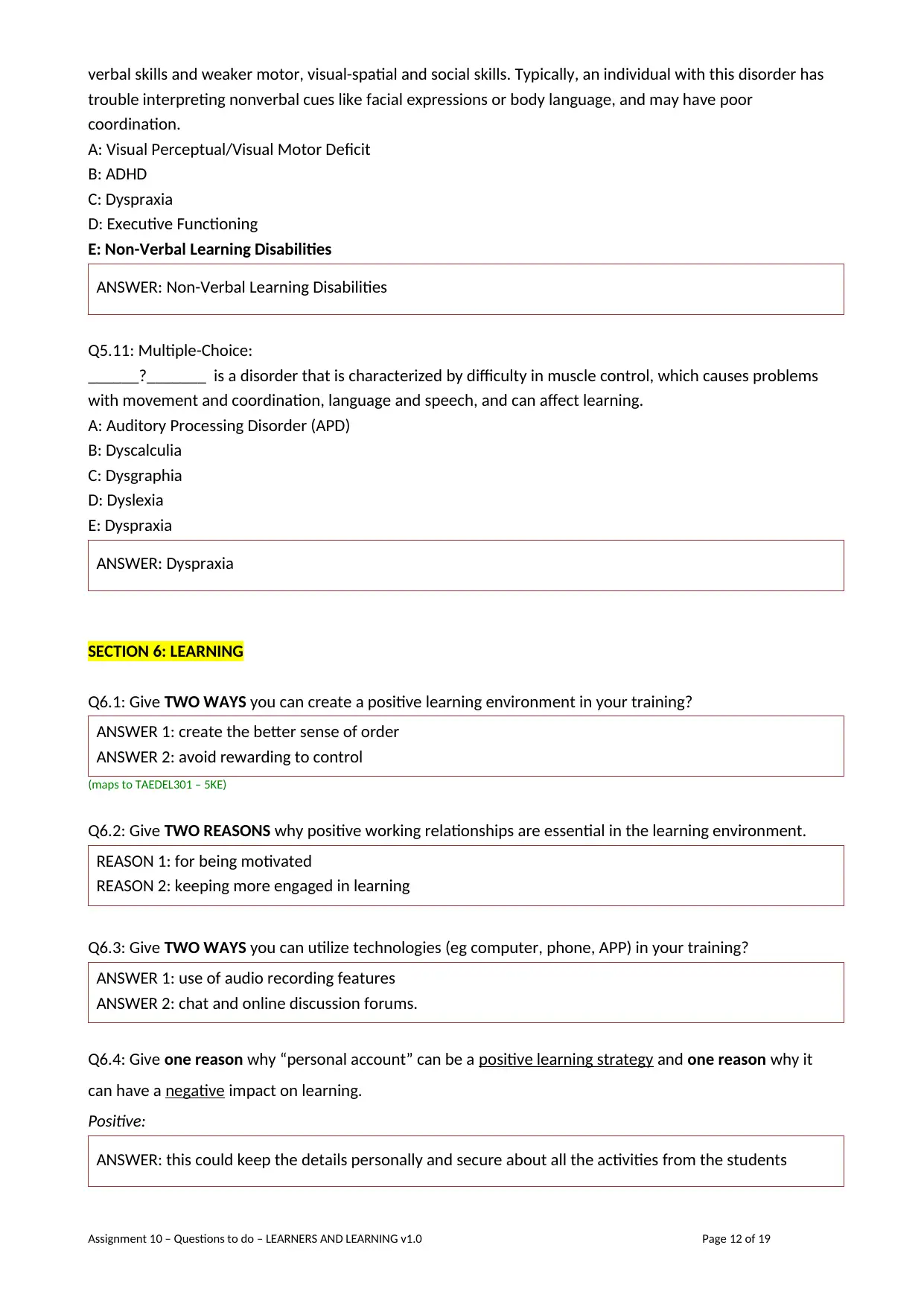
verbal skills and weaker motor, visual-spatial and social skills. Typically, an individual with this disorder has
trouble interpreting nonverbal cues like facial expressions or body language, and may have poor
coordination.
A: Visual Perceptual/Visual Motor Deficit
B: ADHD
C: Dyspraxia
D: Executive Functioning
E: Non-Verbal Learning Disabilities
ANSWER: Non-Verbal Learning Disabilities
Q5.11: Multiple-Choice:
______?_______ is a disorder that is characterized by difficulty in muscle control, which causes problems
with movement and coordination, language and speech, and can affect learning.
A: Auditory Processing Disorder (APD)
B: Dyscalculia
C: Dysgraphia
D: Dyslexia
E: Dyspraxia
ANSWER: Dyspraxia
SECTION 6: LEARNING
Q6.1: Give TWO WAYS you can create a positive learning environment in your training?
ANSWER 1: create the better sense of order
ANSWER 2: avoid rewarding to control
(maps to TAEDEL301 – 5KE)
Q6.2: Give TWO REASONS why positive working relationships are essential in the learning environment.
REASON 1: for being motivated
REASON 2: keeping more engaged in learning
Q6.3: Give TWO WAYS you can utilize technologies (eg computer, phone, APP) in your training?
ANSWER 1: use of audio recording features
ANSWER 2: chat and online discussion forums.
Q6.4: Give one reason why “personal account” can be a positive learning strategy and one reason why it
can have a negative impact on learning.
Positive:
ANSWER: this could keep the details personally and secure about all the activities from the students
Assignment 10 – Questions to do – LEARNERS AND LEARNING v1.0 Page 12 of 19
trouble interpreting nonverbal cues like facial expressions or body language, and may have poor
coordination.
A: Visual Perceptual/Visual Motor Deficit
B: ADHD
C: Dyspraxia
D: Executive Functioning
E: Non-Verbal Learning Disabilities
ANSWER: Non-Verbal Learning Disabilities
Q5.11: Multiple-Choice:
______?_______ is a disorder that is characterized by difficulty in muscle control, which causes problems
with movement and coordination, language and speech, and can affect learning.
A: Auditory Processing Disorder (APD)
B: Dyscalculia
C: Dysgraphia
D: Dyslexia
E: Dyspraxia
ANSWER: Dyspraxia
SECTION 6: LEARNING
Q6.1: Give TWO WAYS you can create a positive learning environment in your training?
ANSWER 1: create the better sense of order
ANSWER 2: avoid rewarding to control
(maps to TAEDEL301 – 5KE)
Q6.2: Give TWO REASONS why positive working relationships are essential in the learning environment.
REASON 1: for being motivated
REASON 2: keeping more engaged in learning
Q6.3: Give TWO WAYS you can utilize technologies (eg computer, phone, APP) in your training?
ANSWER 1: use of audio recording features
ANSWER 2: chat and online discussion forums.
Q6.4: Give one reason why “personal account” can be a positive learning strategy and one reason why it
can have a negative impact on learning.
Positive:
ANSWER: this could keep the details personally and secure about all the activities from the students
Assignment 10 – Questions to do – LEARNERS AND LEARNING v1.0 Page 12 of 19
⊘ This is a preview!⊘
Do you want full access?
Subscribe today to unlock all pages.

Trusted by 1+ million students worldwide
1 out of 19
Related Documents
Your All-in-One AI-Powered Toolkit for Academic Success.
+13062052269
info@desklib.com
Available 24*7 on WhatsApp / Email
![[object Object]](/_next/static/media/star-bottom.7253800d.svg)
Unlock your academic potential
Copyright © 2020–2025 A2Z Services. All Rights Reserved. Developed and managed by ZUCOL.





